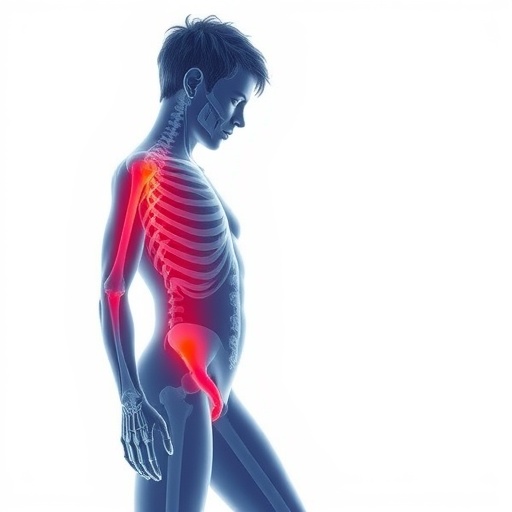Musculoskeletal pain is increasingly becoming a focal point in pediatric research, yet it remains widely overlooked in primary care settings. Recent findings from a study led by Mason, K.J. and colleagues reveal significant trends in the presentation of this type of pain among children and young people who seek primary care. The research utilizes a robust electronic health record database, offering insights that could reshape how pediatric practitioners approach musculoskeletal complaints.
This comprehensive study emphasizes that musculoskeletal pain is not merely a transient issue affecting a minority of children, but rather a burgeoning concern that necessitates systematic attention. The data indicate that over time, a notable increase in consultations for musculoskeletal pain among young patients is evident. This trend raises urgent questions about potential underlying factors contributing to this rise, including lifestyle changes, increased screen time, and a reduction in physical activity.
By analyzing electronic health records, the study paints a vivid picture of the increasing prevalence of musculoskeletal issues in children. Specifically, the authors found that conditions such as back pain, joint pain, and other related disorders are more frequently reported now than they were just a decade ago. This data suggests not only a need for awareness among healthcare providers but also for parents to remain vigilant regarding their children’s physical health.
The implications of these findings extend far beyond immediate medical care; they signal a potential healthcare crisis. If the trend of rising musculoskeletal pain in children continues unabated, the long-term consequences could prove detrimental, both physically and mentally, impacting a child’s development, education, and quality of life. The study anticipates that without proper intervention, pediatric patients might experience a continuum of pain that follows them into adulthood.
A critical aspect of the research includes identifying the risk factors associated with musculoskeletal pain in young individuals. The authors highlight that psychological factors, such as anxiety and depression, correlation with physical pain in a significant subset of children. This relationship underscores the necessity for a multidisciplinary approach when addressing the health needs of young patients, integrating physical and mental health services.
Furthermore, the study details how engagement in physical activities has progressively diminished among younger populations. With the rise of sedentary lifestyles, influenced by technology and changing societal norms, the foundation for musculoskeletal health is increasingly compromised. Childhood obesity, for instance, is linked to increased strain on musculoskeletal structures, thus exacerbating pain symptoms. Educating families about the importance of regular physical activity is vital to curbing this trend.
Additionally, the report discusses gender differences in the prevalence of musculoskeletal pain. It reveals that girls are more likely than boys to report chronic pain, with an explanation that could stem from variations in social, emotional, and physical development. Addressing these disparities entails acknowledging that each child may require tailored assessments and interventions to manage pain effectively.
Cost-benefit analyses of treatment options for pediatric musculoskeletal pain are also gaining traction in academic literature. The study encourages policymakers and healthcare leaders to invest in preventive measures rather than solely focusing on reactive treatments. Establishing programs that promote better musculoskeletal health — through school initiatives or community engagement — could not only alleviate current burdens but also prevent future complications.
Critically, the research urges further investigation into the socio-economic factors impacting health outcomes. Communities with limited access to health resources often reflect higher incidences of untreated musculoskeletal complaints. Identifying such at-risk populations can catalyze targeted public health campaigns, focusing on accessibility and equity in healthcare interventions.
Education and awareness campaigns aimed at both healthcare professionals and the general public are essential in changing perceptions surrounding pediatric musculoskeletal pain. Since many parents may dismiss their children’s discomfort, believing it to be a normal aspect of growing up, enhanced awareness could lead to earlier diagnoses and better outcomes. Healthcare professionals are encouraged to have comprehensive discussions with families about signs and symptoms of potential problems.
For practitioners, the findings illuminate a crucial need for continued professional development and training focused on musculoskeletal pain management in children. With the landscape of pediatric healthcare evolving, practitioners must equip themselves with the latest research findings and treatment methodologies to respond effectively to the challenges posed by this growing concern.
In conclusion, the study by Mason et al. captures the urgency of addressing the increasing trend of musculoskeletal pain among children and young people. It emphasizes the importance of a proactive, comprehensive approach that includes preventive measures, enhanced awareness, and improved access to care. As healthcare continues to evolve, it is critical that attention to pediatric pain management becomes a priority. The transformative potential of this focus can foster healthier futures for children and young adults, ultimately cultivating a healthier society as a whole.
Subject of Research: Trends of musculoskeletal pain in children and young people consulting primary care
Article Title: Trends of musculoskeletal pain in children and young people consulting primary care: an electronic primary health care record study.
Article References:
Mason, K.J., Jordan, K.P., Bailey, J. et al. Trends of musculoskeletal pain in children and young people consulting primary care: an electronic primary health care record study.
BMC Pediatr 25, 961 (2025). https://doi.org/10.1186/s12887-025-06296-y
Image Credits: AI Generated
DOI: https://doi.org/10.1186/s12887-025-06296-y
Keywords: Musculoskeletal pain, children, primary care, electronic health records, pediatric health.




